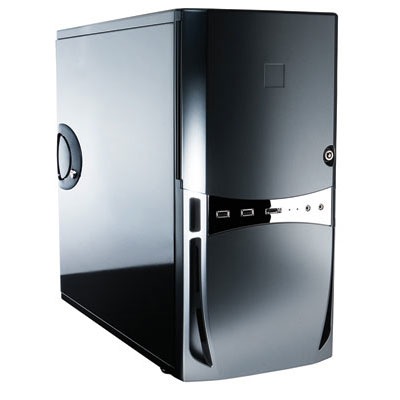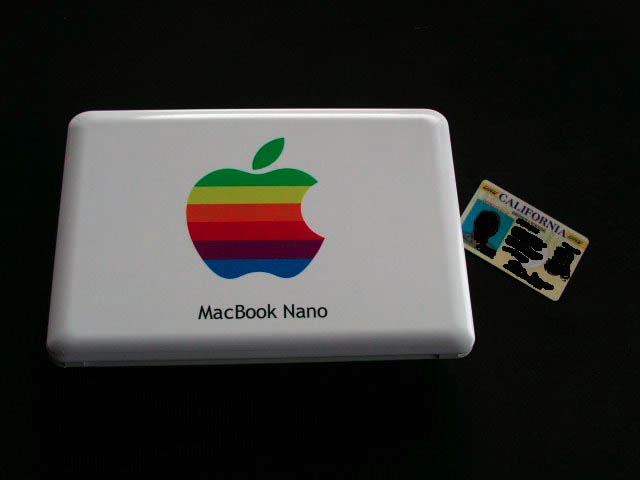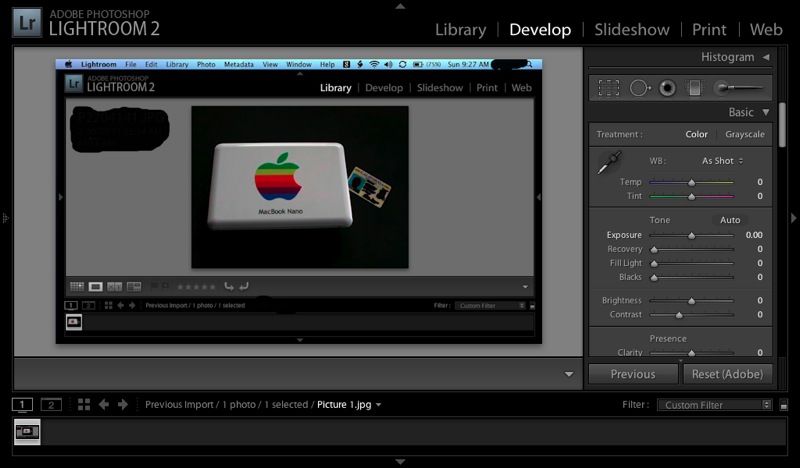With thanks to FU Steve.
Having earlier explained how he hacked an MSI Wind netbook for portable computing (“The netbook Apple will not make”), the pseudonymous FU Steve touched base with me last week to mention that his iMac 24″ – a late-2006 white model, like mine – was beginning to show screen artifacts which indicate imminent failure of the graphics card. I mentioned that Apple wanted $900 to repair mine, a ridiculous sum, and that put FU over the top. He decided to build a Hackintosh. More specifically a machine to equal the performance of the ridiculously overpriced MacPro, naming his ‘build’ the HackPro.
Here are extracts of the interview I held with him.
TP: I understand you are getting all the parts for your HackPro. Could you share the details with my readers?
FU: Glad to. By the way the machine will run Snow Leopard and because all the components can be shipped overnight and come with a three year warranty, if something goes wrong I can simply replace a faulty part in 24 hours, rather than losing my machine to Apple for weeks. The single costliest component is the CPU at $220.
My component list excludes a monitor but includes a keyboard, mouse and hard drive, but if you have these already, the cost obviously drops. I’m including the long form descriptions below so that there is absolutely no question about the parts used.
- EVGA GeForce 9800 GTX+ Video Card – 512MB GDDR3, PCI Express 2.0, SLI Ready, (Dual Link) Dual DVI, HDTV
- Antec Sonata III 500 Quiet Super Mini Tower ATX Case (Black)
- Antec TriCool 120 3-speed fan for HDD cooling
- Intel Core 2 Quad Q9550 Quad-Core Processor, 2.83 GHz, 12M L2 Cache, 1333MHz FSB, LGA775
- Gigabyte GA-EP45-UD3P LGA 775 Intel P45 ATX Intel Motherboard
- Sony AD-7240S-0B Optiarc DVDRW Drive – DVD+R 24X, DVD-R 24X, DVD+RW 8X, DVD-RW 6X, DVD-RAM 12X, SATA
- Sony Multi-Card Reader/Writer MRW620-U1
- 8gB (4 x 2gB) Patriot Extreme Performance Viper Series 4 GB PC2-6400 DDR2-800 Dual Channel Desktop Memory Kit nVidia EPP Certified – PVS28G6400ELK
- IOGear USB 2.0 Bluetooth Micro Adapter GBU421
- 1.0TB Samsung Spinpoint F3 7200RPM 32MB Cache SATA II HD
- Apple keyboard and mouse – both wireless
- Arctic Silver thermal paste
All told that lot ran me $930 without a monitor. The only tools you need are a Philips screwdriver and a modicum of grey matter. Between the Antec case and the motherboard you have all the connecting cables you need. You could do without the Sony Card Reader if you already have a card reader, but installing it in the box cuts clutter and the cost is only $18. Likewise, you don’t need 8gB of RAM (though Snow Leopard can use all of it) as the speed increase in Lightroom is some 8-12% compared to using 4gB, but RAM is now getting so inexpensive, especially if you watch out for rebate deals, that it’s not a lot more if you use 8gB. There is faster (and costlier) DDR3 memory available, but you trade speed for stability. Not good. It never does to be at the bleeding edge of technology if you are paying for hardware with your own money.
If you prefer to use a wired keyboard and mouse you can delete the IOGear Bluetooth adapter ($18), but may need to add USB A-to-A extension cables if your monitor does not have any USB sockets, as the Antec case will likely make its home below your work desk. That can be a bit of a stretch. Either way, you will need to borrow an USB wired keyboard and mouse for the setup. Your system will be unable to recognize bluetooth wireless devices until …. you have accessed the system, and you cannot access the system without a keyboard! It’s a Catch22.
If you feel spendy, you can upgrade the CPU to a 3.0gHz (Q9650) Intel Core2 Quad for $50 more, but that seems a lot to pay for so modest a speed increase – 23% more for a 6% speed bump doesn’t solve, in my book.
TP: Do you have preferred vendors?
FU: (Laughing). Yes. Anyone who is cheap and charges me no sales tax! I used Amazon and Tigerdirect.com. Both are easy to deal with in the event a faulty component needs to be replaced. Those residing outside CA may prefer Newegg.com which charges sales tax to CA residents.
TP: But the MacPro uses the Intel Xeon ‘Nehalem’ CPU (i7 socket) with 8 cores whereas you are using the older 4 core ‘Yorkfield’ (LGA775 socket)?
FU: Yes. The key advantage of the 8 core in the MacPro is faster video processing. My primary use is with Lightroom and Photoshop – I am a still photographer – so the added cost of the 8 core makes no sense as these applications do not take advantage of it.
TP: Don’t you have to be an engineer to build this thing?
FU: (Laughing). You have to be kidding me! A 12 year old could put this together – it’s easier than Lego. All the connectors are keyed so you cannot get it wrong. You install the motherboard in the case which already has a power supply installed by the manufacturer, plug the memory and graphics card into the motherboard, connect the power supply, graphics card, HDD and dvd burner cables to the motherboard and plug in the fans. There are no fewer than four fans, by the way – GPU, CPU, power supply and case. And the case one is no less than 4.5″ in diameter – quite a change from the toy ones in the iMac. You can add a fifth to cool the HDD for all of $15 if you use several hard drives – the case will accommodate four HDDs. And the whole thing is dead quiet. And did I mention the removable, washable air filter?
TP: Ok, so the assembly is easy. How about the software part?
FU: Just Google for the fix. It’s super easy and the installation allows fully automated system updates. I bought my Snow Leopard update disk from Apple for $29 and that’s what I used.
TP: Legality?
FU: Look, Apple has stolen from me for years. Every single piece of Apple hardware I have owned has broken after two or three years and proved impossible or uneconomical to fix. How on earth can Apple’s false advertising (“It Just works”) be any more legal than what I am doing? That should read “It Just Breaks”. And now my iPhone consistently drops calls – in San Francisco of all places – because Apple’s and AT&T’s greed has resulted in so many sales that AT&T’s systems are simply overloaded.
Apple maintains that its OS can only be run on Apple branded hardware but that has yet to be tested in the courts. Further, the fact that Apple has not gone after the hacker community suggests they have concerns that they might not legally prevail. And I paid them for their software, many times over, if you look at all the hardware failures I have suffered over the years.
No, given that the little guy like me has no possible redress against Apple’s consumer fraud, it’s more than a little ‘holier than thou’ to argue the legality case here.
TP: So what’s the performance like?
FU: No idea as I haven’t assembled everything yet. But I can give you some meaningful predictions. Geekbench on my iMac (2.16gHz, ATI7300, 3gB RAM) reports a reading of 2850 and I expect that the HackPro will come in at 6000 or so, so roughly twice as fast on CPU intensive tasks like converting RAW files. On video I would expect a similar performance increase as the nVidia 9800 GTX+ card I’m using is a rebadged GT150. The current HackPro uses the GT120 which is a rebadged, and more modest, 9500GT. More Apple and nVidia spin. So the HackPro will be better as regards graphics capability. The card has dual DVI outputs, by the way, meaning it can drive two regular 24″ or smaller monitors or one 30″ dual-DVI display at full 2560 x 1600 definition.
I could overclock the CPU and GPU and get even more performance, but I’m conservative by nature and prefer to trade speed for reliability.
TP: And the case?
FU: Can you say elegant? No boy racer looks or neon lights here:

Antec Sonata III case
Antec has been making high quality cases for years and this one is as good as they get. HDDs slide in on rails and there are several externally accessible bays behind the top door for things like DVD burners, card readers, etc.
TP: Thanks, FU. When can we expect results?
FU: Give me a couple of weeks or so. One final thought. For Windows users, this machine will run Windows with no hacking, and will run it faster than all but the costliest gaming machines.
The results can be seen in Part II here.

